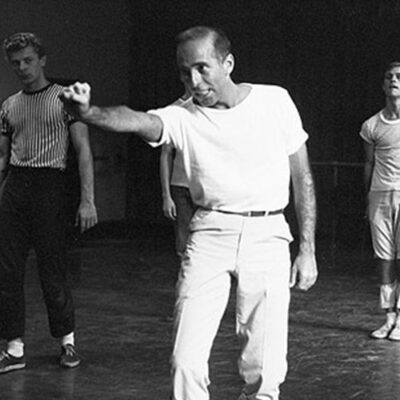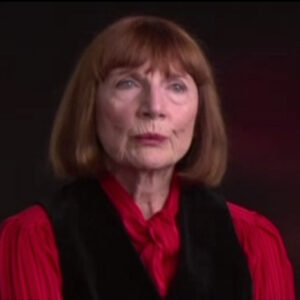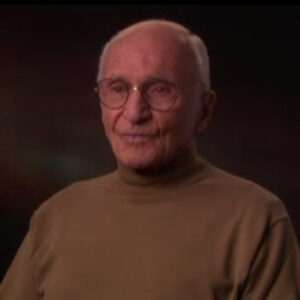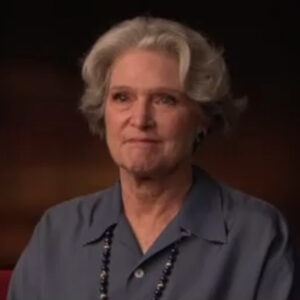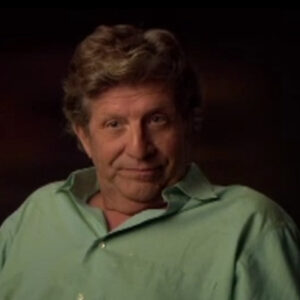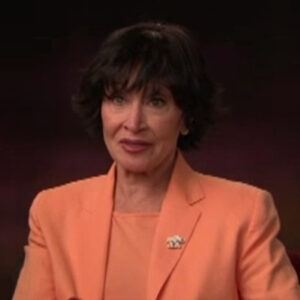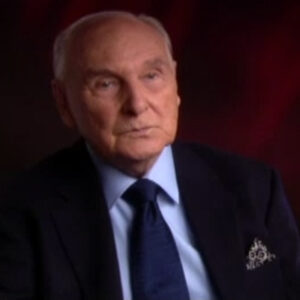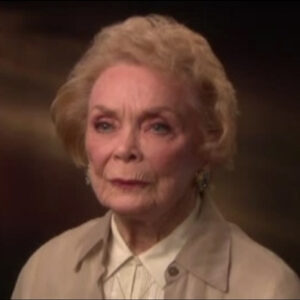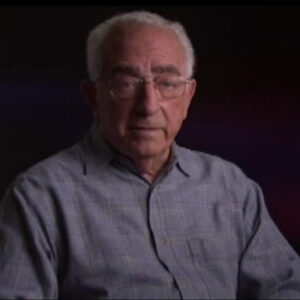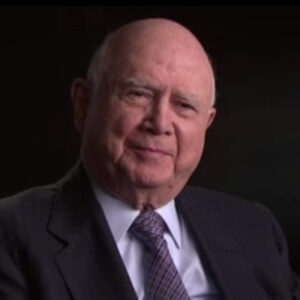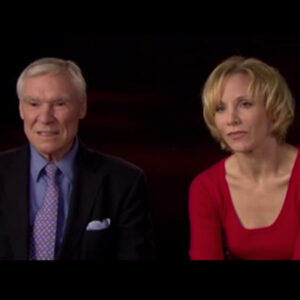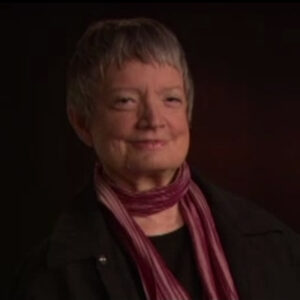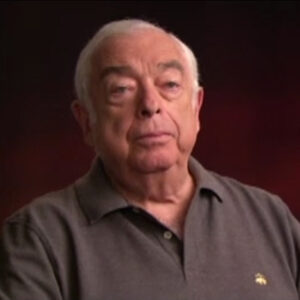Speaker There were two instances where I realized that I was going to be one of Jerry’s dancers, one was when he was choreographing a piece to Cinderella. I think it was called an evening’s waltzes. And I was taken in the corner there. And it was when one of my first experiences with Jerry and.
Speaker All right, let’s revisit that. He really picked on me a lot.
Speaker But it was I could tell already that there was an affinity going on and it was really to try to get the best out of me. I was in the Corps, but I was already given a lot of attention. And sometime shortly after that, I think it was after that that Vialet Verrity left to see her guru in India. And I was thrown into green girl dances at a gathering and I was just 18. And it was pretty devastating because I’d never done a solo in my life except for workshop. And I had only three years of ballet by the time I got into the company. So I was everything was backwards for me. I was learning on the job. And so the the usual kind of excitement around getting something wasn’t excite for excitement. For me, it was fear and it was like, oh my God, they’re going to find out, I don’t know how to dance. And Jerry gave me that role so guilty helped me at night. We’d go up in the main hall and she’d run me through the variation and I was really not suited to it. At 18, I was much more suited to it as my career progressed. But then already he had kind of selected me and picked me out to to do the roles and entrusted me with a great deal more material.
Speaker And I was equipped to handle the problem. Yeah. OK, good. That’s right. Oh.
Speaker That’s really kind of extraordinary. I mean, I know that. He was really good, he had a good eye for young talent. What do you suppose would possess him to throw you into dance at a gathering at such a young age?
Speaker Jerry threw me into dances at a gathering I can only assume, because I’m not in his mind, I have this sense that we were plugged in somewhere that had nothing to do with the frontal cortex. And when he saw something and he saw somehow that part of me understood it without knowing what it was, he trusted that outcome.
Speaker The problem was, of course, that I couldn’t deliver it consistently because I really didn’t have the carriage for the car. You know, I really didn’t know what I was doing in the beginning. But for some reason he saw something. I assembled things. I assembled the artistic portions of things before I knew how to put the technique down so he would sometimes get it and he would sometimes not get it in terms of product, what he needed. But a lot of the time he did. So he he kind of impatiently waited for that to occur. So here we are talking about this.
Speaker I’ve heard some people say that was the Robbins value that they found. They felt best dancing. That was the most special experience for them.
Speaker Was it like for you dancers at a gathering was so special. It was for me, it was pivotal in terms of my first of all, my being exposed to the audience, my my coming to the foreground. There were very, very personal human parts of dancers at a gathering that allowed us to flesh ourselves out in ways that weren’t necessitated in other parts of the repertory. And it allowed for individuation and kind of personal thumbprints to to show up.
Speaker It could be it could be very structured in the way that Jerry wanted certain things from us and he wanted a certain effect. And at the same time, it allowed us to come through the material and it was very important that it be personal. The other thing very, very special about dancers specifically is that when we worked with Jerry, we marked very frequently rather than do full out, we were told to market to just half go through the motions so we could discover a more organic quality in it than the actual doing. It was more being the thing than doing the thing. And then you could again appropriate the technique and then modulate it to the level to which it needed to be performed. But it had these qualities, these tones, these shapes, these textures that needed to be have what would it be, gradients or variables that needed to occur. And so that that was a rich piece in that way, you know, and it could show up in the moment if you could stay present with it.
Speaker It could show up in the moment. So it was very alive piece. And that way it really couldn’t be contrived.
Speaker Can you for somebody who is a little bit abstract, what you’re talking about. OK, for someone who is maybe not so familiar, can you give an example in the belly of what you mean?
Speaker It’s very challenging to describe specifically what I mean about dances at a gathering, there had to be it had to be so in the bones, in the cells. So it had to be so rehearsed and so practiced that it came off looking like water off a duck’s back and it needed to have that quality. It couldn’t be forced because the effort came across. And if it came across as effort, it wasn’t dances at a gathering because it was really about what was happening between the dancers or between the dancer and the audience or this kind of dialogue. If it was a solo, this kind of dialogue, this internal dialogue that was happening between you and yourself and inviting creating enough space between yourself and the audience to invite the audience into your personal kind of discourse.
Speaker And it’s very hard to describe because it’s very it’s a visceral thing for an answer, and those things don’t separate out, it would be like saying here’s a scramble to get get the yolk, get me the white, you know, and and those things are hard to give language to.
Speaker Challenging, not impossible, but challenging what you did it really well and footage to prove it.
Speaker OK, so let’s talk a little fancy phrase is we have a beautiful recording of you.
Speaker Yeah. Tell me what you remember about your coach.
Speaker Jerry was meticulous and unceasing in his coaching. A fancy free. I think there were numerous reasons for that. It was one of his first pieces, a huge success. And he felt deeply attached to it, that it was very precise and executed in a certain way. The other part was that it could become very much a period piece if it wasn’t enlivened by the people who were performing at the present time. What I have noticed, and I’ll just do this by point of comparison, I have seen it performed elsewhere other than city ballet and other performances. And the minute the timing, a single second of the timing is inaccurate, the entire ballet just may as well not be presented. It had to do with the timing. His comic timing and his theater timing was impeccable. It was absolutely impeccable. And if it’s missed, the piece is lost. It’s absolutely lost and it loses its validity. And so I could see why he was absolutely stringent when it came to rehearsing. Unfortunately, sometimes from our personal standpoint, it it was very challenging because we felt that we I’m giving a royal when you hear here that it was just so hammered into the ground that you felt like a dried up piece of beef. But at the time you were done, there was no vitality. There was nothing. But probably from the audience standpoint, it was live. It was specific. It had the required specificity and the accuracy to come across. But as a as a performer, it was it was sometimes tedious. But I do understand his being meticulous and wanting that clarity in that definition, because it really makes the difference. I have a lot more to say on fancy, but I’ll wait for some more questions.
Speaker Also, when he coached for the filming specifically, he took us as a cast and said, go after your corners like we were a group of actors and create your characters. How long have you known each other? You know, what have what have you meant to each other? How are you looking at that group of people?
Speaker How are you going to play with one another and give it your own personal touch? And then, of course, if we went too far and took too many liberties, we would hear about it. And the other part that I’ve realized since I knew I was going to be talking to you was for me, Jerry was an intrinsic part of my life and my career because I actually didn’t grow up with ballet. And I grew up watching movies, million dollar movie on television every week and memorizing everything in musicals. And there he was in my house and I got to do musicals without singing. And I couldn’t wait for those things. I mean, that was the thing I really wanted to do. And so here we were doing fancy free and I got to do all these kind of 40s, 50s kind of Broadway things. And it was a really great opportunity to, you know, to just kind of go back and recreate these kinds of pieces, you know, the part where the boy was just going to grow.
Speaker And then, yes, I certainly know that last moment Roger told you about that, um, about the moment where he’s about to touch her and pull away.
Speaker I don’t recall exactly that. That moment. There was so many moments where he would kind of try to make it about a freeze frame and how important that was that he was stopping his impulse. But I might be imagining that I don’t recall verbatim what Jerry said about that moment. I remember certain other moments where I would just it’s very hard for me at this point to differentiate what I was imagining Jerry said and what Jerry actually said. Sometimes I want to make a disclaimer about something, because we’re also talking about me decades ago in a situation decades ago, and I don’t have a claptrap memory and I have a vivid imagination. So I could make stories up for you and tell you something and it might not be the truth. So I can fabricate something if you like.
Speaker OK, that’s sweet.
Speaker You know, first of all, it’s an unusual moment very often see in a valley and say, oh, it’s just so full of meaning for me.
Speaker Well, that’s his area of expertise. There’s those moments, those those things of that creates the theatrical tension. Oh, God. I really, really would love to. And I’m just about to. And now I’m going to stop. And so you get that’s why your memory of that moment is so frozen in time. It’s that kind of where we gasp and we go, oh, it could happen. Is it going to happen? He leaves us titillated. He leaves, he leaves that moment where we’re just hanging there. And that’s also our jobs performances to create those moments where you’re just are you are you did it, didn’t it? Did I really see that?
Speaker Didn’t I see that it creates it actually causes the audience to participate. It includes you. It includes us, otherwise we’re just showing ourselves as craftspeople, letting you see us and Jerry always invited you to engage in some way humanly as a human, I’m not sure human lives or as a human. He he he created situations and dynamics that allowed space for the audience to engage and let their imagination kind of go up.
Speaker I just want to get back before we leave it totally to dances together, because, again, it’s so rich.
Speaker What do you recall about what he told you about the ballet in terms of the atmosphere, how you would relate to each other for its time? It was quite different in those in that regard, I think. What did he explain to you about all that?
Speaker I really don’t recall the specificity of guidance on all the parts of Dance’s regathering. I do know he was very particular in moments, for instance, touching the ground at the end.
Speaker The man who touches the ground in the end and really taking time, you know, he really had no fear of taking one’s time and had no fear that the audience was going to be disengaged or bored by us taking our time, for instance, at the end, taking our time to look, to watch, to absorb. It might mean quite a change, actually, in the idiom in a way that at least certainly for city ballet dancers to stop and regard ourselves as human dancers rather than just dancers as as a as a tool for the choreography.
Speaker But at the same time, the choreography was absolutely clear and had to be adhered to. But there were all sorts of interchanges and shapes there that were so much about the space between the dancers and what was happening in the space between the dancers. But that, again, was jurys, theater background and all of that pervaded or created textures that again is exchanged. It’s in another place than a verbal place, even though he can verbalize it or could verbalize it. Our place of perceiving is is a different sphere of discourse. I it’s very it’s very hard to communicate that, yes, you could ask for certain things. You could say, I want this in this in this heated green girl in front of me three times before I would run it in every city we went to. He loved doing it. I don’t know if you know that Rudolf Nureyev wanted to do it. It’s a variation and he loved it. It was the most delicious, phenomenal timing and this kind of throw off piece that required so much focus and such precision. And yet it needed to look like it just it was in French. He said, don’t sample it. All of those dancers were looking like it was in our skin. It’s under the skin, it’s not on top, it’s not something superimposed, it’s like it came from the dancers and how to describe it. I really don’t know how to describe it.
Speaker And I don’t know how you really evoked it in the Wind Waltz, for instance.
Speaker I do remember he said really like leaves blowing. You know, in the beginning it had to be like you were blown from the side and asking over and that everything melted. It didn’t have edges. And so what would it be like if the wind were pushing you from the left side or under and you were being blown over in around the way of leaning, the way of going forward, the way of breathing?
Speaker There was so much breath running through that that that oh, I wish there was a way to describe this again.
Speaker You’ll probably get more clear, concise answers from other people on this. It’s it’s more of a kind of somatic response. I have to these and it’s hard to describe.
Speaker OK, all right. You mentioned that dance did for you. What kind of a dancer mr.
Speaker So intelligent is he had a there was a spark, he got kind of lit up from inside.
Speaker How can I call it seeing seeing behind the eyes that kind of intelligence in Spanish dancing and also in certain kinds of meditation.
Speaker When I do yoga, you place the seeing the at the base of the skull. So the eyes are behind. They’re not in front, so it’s not frontal and accosting. So this is in inward seeing. And that’s what also creates the actual visually for the audience when a dancer can see inside and leave the room for the audience to come towards them. I think that’s what Jerry did. Rather than being outward at the same time, there were the very, very outward expressions and other pieces, not perhaps in well, in fancy free. There was that very outward kind of Broadway look mind dancing kind of thing that you had to do. They were big, they’re arched, they’re high arch and that very kind of very high tacky, overaged, Hollywood exaggerated quality that was also there. So you could play in his verbiage was so wide. He said he understood everything that was required for theater, everything that was required for musical theater, everything that was required for serious theater and quiet as well. And so he he just had this palette and he could call on that palette at any point in time. Immediately there was there was that plug into what I call the cosmic soup, which is behind us. You know, our eyes organize everything as matter. But actually what you do is you plug into what’s back there and then you just pull it up and throw it out. And Jerry was doing that all the time. So it he had a huge palette and a huge. Array of things to pull from and he could pull them up in any moment and he looked he could be sprightly, he could be dance, he could be light, he could be angular. He could be kind of viscose and wide. It depended on what what the piece called for. And he could be all of those things. You just said that it’s not mercurial because Mecurio somehow for me, implicates that it’s light and it kind of goes away, he could really go in and out of whatever was required.
Speaker You know, if you can, just because you didn’t start out with the subject, all right, you just indicate refer back to just give me a sentence as to the subject that you were just referring to. My question to you is, what was Jerry like as a dancer?
Speaker Jerry, as a dancer was not what we would perceive as a ballet dancer in terms of his skill level or perhaps his physiology. But he was very much a dancer. How do I describe that? What I mean by that? He was fassel in the way that he could communicate aspects of dance without actually being the the actual perfect vessel in terms of our very, very strict regulations about what a dancer is supposed to look like and how they’re supposed to communicate that particular line or that particular aspect physiologically. But he could always communicate it energetically and in terms of craft.
Speaker Could you compare the kind of freedom that you got when you danced Jeri’s ballets as opposed to Balanchine’s ballets and how like what happened when they coached you? How did that manifest itself in the coaching or in the notes you got after?
Speaker We are talking about in terms of comparing Robins and Balanchine as a coach. There is no comparison. They have to be two separate discussions, two very, very distinct ways of working, two distinct ways of seeing and understanding and distinct agendas and expectations.
Speaker For me, Balanchine was many things and both of them were paradoxical. OK, that’s where they could meet. They were both paradoxal, both in their expectations and. How can I first ask oh, let’s leave it right there and I’ll try to finish that thought with Balanchine, I saw, as he said, we were tools for the choreography. So we were understanding ourselves more as post-modern architectonic kind of bodies in space with music and not so much as personalities or stars or seeing ourselves ego quickly. I mean, it was just here I this is what was given to me. How do I serve the music? How do I serve the ballet and how can that best and most clearly be executed so I don’t get in the way of the material. My personality doesn’t get in the way of the material. I don’t act the material.
Speaker I just execute what’s necessary so that it is clear and crystalline is possible and that is giving the choreography its due and the music its do. In truth, that’s only partially true because. We are human, and Balanchine loved our specialness and our uniqueness and loved the the variables that one dancer would bring to a role that perhaps have been created for somebody else.
Speaker And he was the first person to change his choreography if he found that somebodies physiology or personality or energetically had some kind of a nuance or something that somehow really either necessitated a change so that both the dancer and the choreography were better served by that change. And he was the first person to do it. And by the time I got into the company, this gorgeous lesson of taking risks was first and foremost in our training, putting ourselves aside and putting our limitations aside, our perceived sense of limitation and just going for it was one of the biggest gifts of being a Balanchine with Jerry. Jerry had a very clear idea of what he wanted and. He could be grueling in in executing and trying to extricate from us what it is that he wanted or what it was that he wanted at the same time. I knew for certain that the reason I was there because he wanted me in this piece or the people that he chose or we again, any of us that were chosen for roles or was because at some level, even if he wanted to pull his hair out with us, he wanted that particular person for a particular quality that was going to imbue the role with what that piece needed and what was necessary to carry it to to bring it to full fruition. Not that he didn’t trust his material, although sometimes he didn’t trust us. And sometimes he didn’t trust the material. And, you know, we were sometimes caught in between, frequently caught in between. And that was a challenge. That was a challenge. And sometimes to put our. Ego on the side and go, OK, I can see he’s having issues here and if I really want to. Allow myself to go off into personality issues and stop forgetting the work in front of us, that can become a really big problem, which can happen, did happen. But I always trusted what Jerry was looking for and also because I needed what Jerry was looking for as food for myself.
Speaker When you were smart, that always helped with him. I think I’ve heard people say Jerry likes honest movement. Do you think that’s true? And can you explain?
Speaker Very much so. Jerry definitely liked simple, honest movement. I think authenticity and honesty was the that germ, that wonderful germ, that baseline of where Jerry wanted all of our work to begin.
Speaker And again, it’s the being not doing aspect, it’s a kind of a very Zen way of understanding, of course, how does somebody become very physical and not do when you have to be doing, you know, the level of technique, the level of expertise or the accruing, you know, getting to that point with technique to where that can become part of who you are rather than what you’re doing so that you can finally become the piece rather than do the piece is takes a lot of time, energy, effort. And fortunately, if you’re fortunate enough to to do a piece repeatedly, then you start to wear it. I think I think a good way to describe that is one needs to start to wear the ballet rather than do it. And so then then we need to find a way to get into that work from underneath and some sort of subterranean level and some primordial level to get back behind it and under it rather than to appropriate something or put it on. And that’s where Jerry lived with his work and that’s what he wanted from us. Even if it was Broadway or showy, it still had to be something about it had to be very authentic and. That’s also it’s very resonant in that place, it’s softer, it’s resonant, there are no hard edges, and that’s also, I think, what works for the audience. That might be an assumption, but it might be what works.
Speaker What was Jerry like compared to Balanchine in rehearsal?
Speaker Balanchine and Jerry were very different in rehearsal, for the most part, Balanchine had his work done before he came into the studio and showed it to us and we did it. There was no angst. There was basically no process. There’s here’s the ballet. It’s clear he kind of had a direct plug in to God. He came in, he gave it to you, and you just did your job. It was it was not complex. It was not there was no baggage in the room.
Speaker It was basically, can you do this? Go farther with it, go farther than farther with it, make it as clean as possible, make it as precise as possible here and there, showing nuances. He was marvelous at being both the male and female role.
Speaker If it were a partita, if he needed more movement, he could chase us across the room to get his point across. He was very simple. He was very respectful for the most part and expeditious. Very clear, very, very clear.
Speaker Jerry was another story.
Speaker Jerry is process oriented and very often brought a lot of his baggage in and a lot of his angst in and his own insecurities in. And sometimes we had to deal with those more or less skillfully.
Speaker And I think how can I how can I share this information?
Speaker It’s challenging to share it because, of course, those books have been written and everybody’s ready to put them on the coals for it.
Speaker I made a decision some somewhat midway through my career that for whatever reason, maybe for survival, that I understood his process.
Speaker And if he had to be less than polite or less than large that I understood it, that if I was home with some concept and I was a choreographer and I went to my studio and worked it out at night and I came in the next day and I was going to be confronted with those poor humans who can only do so much with their limitations, their physical, emotional, mental limitations. And I’m not seeing product. The thing that I want to see that I saw in my mind that I wanted to see out there, that I want to get there and I want to get with some consistency, that I might be a tortured individual. And so I decided to get into camp with him. You know, that was not necessarily healthy.
Speaker And it could admittedly be a nice, co-dependent state of denial. But at the same time, I thought this is a craftsperson, an excellent craftsperson and somebody whose love I work. I just happened to love. And that’s somebody I happen to care about. And also in terms of balance in the repertory, offered a great other realm to be participating in. And so he was challenging and it was challenging to constantly create and shift my attitudes around those challenges, to be able to perpetually stay open and fluid and receptive in the face of what could be perceived as cruelty or difficulty.
Speaker I just want to make one version. Oh, yes. But tell me about that. About why do you think you did that and how did the dancers feel about that?
Speaker We frequently had different versions of ballets while he was in the midst of creating those ballets, or even sometimes after the fact, there was a sometimes perhaps a not a not an indecision, but a tentative way of viewing his own work as to whether or not it was working for him or what might it be if I go off on this tangent or try it on in this way and try to. To take it in this direction, what does it look like, what will it feel like? Is it cohesive for me? If I add this little piece, will it somehow give some different kind of light or or frequency to this piece that it needs or doesn’t need? When we did five songs, I had five dances that got cut and they were wonderful. Some of them were fabulous. I loved them. And it was really I mean, I heard the stories about when dances at a gathering was being created as well. And I think there are many stories like that. And I it’s not that it was a personal thing. It was really like he was looking at this storyboard and said, OK, this piece works, this piece works, this piece works, or it’s like a menu and deciding which one you’re going to take and, you know, from a very large menu.
Speaker And for us not to take it personally after putting in time, effort, energy and, you know, some modicum of ego to some degree, it was always interesting to have your piece cut, you know, but that happened. And I think that was he was at liberty to do that as a choreographer and it was in service to the peace. Finally, maybe not we may not have been in total accord with that, but I do think that that is a prerogative of somebody creating something. Just like with this film, you get to cut. You don’t have to keep the whole thing. You get to kind of pop the parts that really work for you. That would be my assumption. We didn’t always have discussions about it at dinner, you know, but that would be what I would presume was happening.
Speaker But it’s hard. It’s challenging, yes, yeah.
Speaker I’m going to read you something and ask you if you would comment on it. This is something that Debbie Jowett wrote in her biography of Jerry. She wrote, He didn’t want the mechanics to show how difficult, no matter how difficult, was Balanchine often wanted to reveal what could be done and how would you comment.
Speaker And again, there’s those wonderful aspects were the differences of. The choices Balanchine wanted us to make in showing his work and the choices Jerry wanted us to make and not showing the work in his work, so much of Balanchine’s work and even in class, even when I’m teaching now, sometimes I’ll say we had to show that we were showing and show that we knew that we were showing something.
Speaker So there were these layers of doing something. But we had to have a consciousness of what we were doing, a complete, completely informed organism in terms of direction, trajectories, choice making physically that was so absolutely architectural and that we had to understand ourselves in space, in time, in that way. And then on top of that, we had to show that we knew that we were showing it. And it’s wonderful because when you teach, it’s not that it’s layered. It actually comes very simply. It’s just that it’s so and it’s so set in the cells that it’s not even a second thought any longer. The leg knows exactly where it’s going because you practice it so many times that way and you know it’s going to go there or God forbid it doesn’t, you know, because it’s really bad hair day with Jerry.
Speaker The work had to be there in exactly the same way, but then you had to make it look as though it were not so. So the work actually was doing the work and letting go of the work.
Speaker So the task at hand was to create that level of consciousness and then play it, play with it until it looked like you were actually thinking it up in the moment as if you were just choreographing on the spot. Which is, again, I love that as a tool, because when I see a group of people in front of me and they start to do something and they they’re doing what I tell them, I asked them to do it as if they were making it up now. Absolutely. Now. And there’s I think what juries work was, was that at the same time with this quality of now and very personal.
Speaker So it was layered. It was that first the architecture, then losing the architecture, then going back to it and then knowing the degree to which that that filigree sof and quality of doing and not doing.
Speaker And it’s again, I’m sure there are many people that can analyze that. And like Deborah and other people who could watch that and say what it is for people that have studied, dance and have have really, you know, a pedagogy, a language for that, you know.
Speaker Jerry’s work as more or less difficult and Balanchine to dance. I don’t think that comparison can be made in terms of difficult. It depends what was required. Technically, it depends on the dancer, what is required technically and in any of the pieces. So there were Balanchine ballets that were very easy and very natural for me. And that came quite simply where the physicality wasn’t challenging.
Speaker There were other pieces that he gave me as gifts to increase and improve my technique that, you know, between pieces I would run into the wings, cry and go back again because I knew I shouldn’t be doing them.
Speaker So they were very physically challenging and then therefore very emotionally challenging to be doing the balancing work also necessary and wonderful to have those things so that I could improve. Easier or harder, as again, working with Balanchine was just more simple, it was less encumbered by any issues other than the work itself, very, very clear, unfettered work. It was simply about, are you willing to how much energy are you putting in? How clear is the work? Can I see the leg work? Can I see the intention of this? And is it musical? You know, not and only and there were nuances and there were things required in other pieces that, for instance, did require fully fleshed out humans, even if you talked about it as just steps. That, of course, were the mainstay of my ballets in my repertory in terms of Balanchine repertory, which I was lucky to have because they were very suitable for me and they’d been made before, like emeralds or misleader or anything that required this kind of Jussie, more feminine, more kind of fleshed out work. It was harder for me to do the the Liotard pieces, the Liotard ballets, the pieces that were purely angular and linear and kind of frontal, because, first of all, it wasn’t my physicality. Second of all, I wasn’t as speedy physically as some other dancers and it wasn’t in my nature, but it was totally wonderful and appropriate to be able to do those pieces and learn to execute things clearly without thinking about where am I in this, my ego and my personality. And that was great to be able to do that work. And I loved those as I loved episodes. I look for temperaments. And then, of course, we had all the wonderful comic things with Balanchine IV songs, not my songs, I’m gonna Pearly Queen, all of these other pieces where I really got to jump and be silly and goofy and comic. And so there was that and the same with Jerry. The thing with Jerry was that, again, the minute I started taking liberties, I heard about it big time. And I would have two things taken away.
Speaker I love doing the concert and we even went out to dinner afterwards and a friend of his complimented me on performance and I was out of it really fast.
Speaker He said that was just taking too many liberties and I was having the best time. I was just I thought, oh, my God, I am going to go wild here. And I did. And I didn’t see that for a while.
Speaker And other times, the differences between can can you just reiterate for me again the differences between just ask which was more difficult for you and neither was more difficult to dance.
Speaker They were both completely different animals. Again, different different priorities and expectations. And I love to see the part of art that I loved was I loved the. The ability to go without resistance into the peace and find what was needed by the war rather than have it be necessarily about me, you know, what what does this look like to me?
Speaker What is my interpretation of this? Oh, I see. It’s just linear. I’m going to be really, really dry and I’m just going to do it that way. But then again, there’s a really big issue with that. When I did episodes for the first time for Mr. B, I did it with Victor Castelli. He came into the rehearsal studio and I thought, I’m going to be as bland as I can be, no faces. I’m just going to do the steps, no personality. I’m going to cut her out. Whoever she is, she’s leaving. I did it. And he came and he said, Dear, wonderful.
Speaker Just what I thought. Fabulous personality.
Speaker Then the other thing happened with Jerry, completely the opposite. I thought for dances at a gathering for Purple Girl, I’m going to do my hair over this way and I’m going to put the ribbon over here, I’m going to be just like Alice in Wonderland. So I went, I did my hair, I did the performance, he came afterwards and he said, what the hell was that? You looked like Hedy Lamarr slinking on board some ship. I looked I went home and cried, and that’s what made me realize that no matter what I thought and what I thought I was projecting, I hadn’t a clue I was going to be interpreted differently from how I thought I was doing it and that really I needed some good friends outside to tell me what what it was looking like.
Speaker And a lot of those ended up being writers and journalists and people that I could trust because how one reads is not necessarily how one’s feeling. And you have a certain physiology, you have a certain genetic makeup, you have a certain character, you have a certain innate, intuitive way of responding and moving as a dancer or as an actor. And there’s there’s reasons for typecasting because really that’s what reads. And you can only take responsibility for so much. And you really have to leave it to the choreographer, to the director, to whoever’s in charge to make those choices for you and also to offer those commentaries. So in terms of difficulties, nothing is more difficult than another. It’s just what adaptive qualities do you have to use to find your way through the material? That’s my take on it anyway.
Speaker How observant was Jerry, how observant was Jerry?
Speaker Observe observant and intuitive. He was a very. The hidden animal quality of the observation, a very intuitive.
Speaker Quality.
Speaker But I’m not sure that it was always observant because it was frequently clouded.
Speaker By his own angst or insecurity. And I think he was a very observant human and a very observant artist. Which could not always be in evidence because of the conflicts that arose sometimes with him during his working process and his material. But I think his ability to see and to see other people’s qualities was. Come in omnipresence, it was always there, but it could get it could get layered with something else, with whatever issues were going on, whatever his concerns were, how his eye for detail, what kinds of details would Jerry’s eye for detail was impeccable. And very nuanced it were it had to do with. Seeing all of those small moments, all of those things that make us, again, make us human and make us hold our breath or wait in expectation or hit us somewhere that we don’t quite know what’s being stirred up or evoked, it was more evocative than obvious. It was. So it was again, it was it was a textural layer that’s below the surface. And again, that’s very hard to describe. But he was always looking for that. He was always looking for an honesty and an integrity that had to do with honesty. That’s my sense, at least that’s what I liked about doing his work, and it couldn’t always be had because some of the work actually didn’t always hold water. I mean, sometimes we had to turn some dubious portions of choreography into something interesting. I mean, everything was gold. There were many pieces of gold, but not all of it was gold. And those pieces then, of course, were left to us to try to do something.
Speaker So I was he did he realized that was he honest?
Speaker I don’t recall discussions about Jerry being honest about when something wasn’t up to expectation for him, for himself or not, he didn’t say, look, I’m really having trouble with this. Can you fix it for me?
Speaker There was a time, actually, if I can jump ahead to antique epigraphs where he was very happy with himself. It came it came very, very quickly for him. He worked easily with all of us. He was playful. He was interactive. And I would say more or less that he trusted all of us in our work with him. It happened very easily, that piece.
Speaker And I my recollection of rehearsal is one on one with him, which I remember was doing a Nutcracker period. And sometimes even between a matinee and an evening, we would have rehearsal and I’d be alone on stage and he would just sit with a make or beat up on the stage and say, try this.
Speaker How does this feel? And we would play. We would just play. I’d be up, down, twisted, turning on the floor. And it was generous.
Speaker He was both generous in that process and very trusting and actually quite loving in it. So I think when things came easily to him and he was trusting and loving about it, it was it was quite wonderful. They were infrequent those times.
Speaker Well, we’re talking about yes, search that I recall him telling us about the sculptures that he had seen and how he had somehow had them in the back of his mind for quite a long time, these statues of the women with the glass eyes and that he was I think he was very happy to finally get to the piece and feel that he had somehow come to terms with the material and the memory that he he brought one piece of his memory and a trip and seeing this artwork and then seeing the dancers and kind of bringing them together and merging them into a time space frame that somehow felt right to him. About that, the silence and the level of comfort with the silence and antique epigraphs was wonderfully resonant. Again, so many choreographers have such a sense that they’re going to prove themselves by filling in time and space in a way that there needs to be every step, for every beat, for every count, rather than carving bodies in space and allowing the negative space to be resonant and thick, kind of dance with something and without us having to create meaning, but actually trusting that there’s something there that we don’t necessarily have to fill. But it is filled. And I think the colors and the lighting helped do that. The music, of course, has this wonderful kind of suspension and.
Speaker Way of bringing us into, um. It’s almost like a netherworld.
Speaker There’s a very archaic resonance in that in that piece, at least, I felt again, it’s this kind of behind oneself of feeling in the space behind oneself that. Gerri really understood in this piece. Rather than going out to do something, we would reside behind ourselves and that that taking those archaic stances allows that. You know, we we’ve seen those freezes, we’ve seen those urns, we’ve seen these statues, we’ve all stood in front of that. And then something gets triggered in our what is called reptile brain, where we start to recognize what we know already.
Speaker And somehow he tapped into that place. And it has a quiet two to it that allows us to be a little more contemplative at the same time that we know we’re seeing activity, but the activity has a a quietness to it. A stillness.
Speaker Before we leave and take together graphs, anything you would say about experience? Or memory about making.
Speaker I have lovely memories about very personal memories about working on it once again, because antique epigraphs was something that was basically an easy birth for Jerry and that was such an experience. It was so there was no ambivalence there. There was no antagonism. And so for that to happen was already a gift. Also, at that point in my career, there was there was this kind of camaraderie in this trust going on. So I felt that was very personalized. Um. And I loved I loved the dance quality of the piece that I actually did in it, this kind of incantation in this spellbinding earth relation to Earth quality, because with ballet, so often it’s kind of pink and pretty and saccharine and we have to be lovely and we have to be perfect. And that part I was so over and so to actually have something that was dance, that was this kind of female community and a woman having a sense of self and power, not strength more than power, where it didn’t have to be worn as a badge, but it was simply as that and that he could actually give something to you where you could let that be evident. And so that first variation that I got to do and then play with him on it and part of it felt like it actually belonged to me because he said, what if what if try this? And I would try it and I’d I’d love it. You know, I’d suddenly be on the floor. And what happens if you do this? And and I loved being on the ground, I suddenly felt like, oh, my God, I’m in some other company doing some other work and I’m contemporary. And it had more more of that earth quality that. And that quiet, that kind of scheming, quiet. It happens almost on these planes where everything kind of skims. And shifts, and it’s not vertical, it’s horizontal.
Speaker And I loved that horizontal quality. And that sense of weight, so that was one of it’s not a it’s not a great audience grabber, but personally, I just loved it. I absolutely loved it. I loved the hues. I also loved that we had muted tones and those quiet lights and that that kind of just quietness.
Speaker Yeah. Just because one audience member I always like, I think people were really taken with it. Really I do. Yeah. I’m thinking about.
Speaker Jerry’s whole repertory. What would you say are the defining qualities that reemerge in his ballets or the.
Speaker No matter what the theme is. I’m thinking of things, for example, like regality or the vernacular, things that keep coming up in Jeri’s balance over the decade.
Speaker In your own experience, dancing, you dance so many of his ballet. What are some of those things?
Speaker In Jerry’s vernacular. And the things that I’ve appreciated in his work. That spanned decades, that.
Speaker There’s a wide berth of material, I mean, there really is just an expanse of material and he has a language for so many different.
Speaker Feeling spaces, emotions that. I don’t mean to diminish the fact that there’s a great physicality in his work, but there’s a great humanity in his work and there’s a great there’s a wonderful way I feel that. There is no I think it’s a little bit like when actors there became at a certain point in time, I’m not quite sure when it happened, the every man started to become an actor. There were no longer stars and just beautiful people as stars, even though that gets caught up in the scene. But actors became other people as well. I mean, other people became actors. And I think somehow Jerry took ballet out of. The idealized version of perfection into the commonality, the unique, beautiful commonality of the human experience. And the things that actually join us in our experiences, the the kind of naiveté in that sweet moment of youth in fancy, free of the soldiers and that kind of goofiness and play of the girls and the boys or the young women and young men in that predicament in that particular time. And he had a way of encapsulating these time frames in these periods in time somehow. And he he he had precedence for that doing watermill doing fancy free. He had as artists. Do they have the preview to what is the next thing that’s about to emerge as normalcy? And he had a way of encapsulating that and giving it to us as public at large. You did not have to be elitist or grow up with ballet to go see a Robin’s piece. He included you as an audience so you didn’t have to develop an affinity for or a pension for. He actually did that without pandering and without diminishing or speaking down to anybody. So he used the idiom, he used the forum and he used the language to actually bridge that place to create. I was going to say an Americana, but it’s not purely Americana because it does translate in other cultures as well. And frequently friends of mine in Europe, for instance, would gravitate much more towards that than they would towards the Balanchine, because Balanchine was a very specific aesthetic and a specific taste and took some growing. Of course, people in a postmodernists were drawn immediately to Balanchine, either in architecture or art or painting. They immediately got Balanchine and there was nothing else. But if they were slightly romantic, slightly different and nuanced in other ways, or couldn’t understand that or didn’t see it or didn’t have an affinity for it, they got robins immediately. So my take on that would be that also culturally there was a slight, slightly different. Softness and a roundness to the work that allowed.
Speaker A wider participation for an audience persay that.
Speaker That would be one one version of how it could be viewed, you know, when you were working together with Jerry, did he ever give you things like maybe you couldn’t do with then?
Speaker With Jerry, the only time that I thought I couldn’t do something was the first time he gave me the lavender girl and Dance’s regathering, which of course became one of my favorite things and actually one of my best vehicles. But I had seen so in it and I didn’t want to slander it.
Speaker I had a picture of how it should be and I wasn’t going to be able to make that picture. And at the time I didn’t realize that he didn’t have a problem with that. He wanted me doing it. And once I get over that, I was fine and then I was happy with it. Beyond that moment, nothing of what Jerry gave me was.
Speaker At odds with my perception of my.
Speaker Let’s say textural capabilities physically, sometimes I had to bring myself up to things, but in terms of what he needed from that particular piece, in terms of it as art. I never had a problem, but sometimes physically I might have to work on something, but that wasn’t really an issue. That wasn’t a challenge with Balanchine. It was the opposite. Of course, I had to bring myself up to the material with Jerry. Actually, I had the opposite experience. There were things I wanted to do, but he didn’t let me do because he felt I wasn’t suited to it.
Speaker And that, again, was this Hedy Lamarr thing going to come back, and I’m not sure that I saw her in too many things, so I can’t relate to it to charity. Right. It’s like, OK, leave me alone.
Speaker I spent a lot of time on this because it’s not really recording. Right. Not a recording of it, but. You were in the original cast of Four Seasons. Yes, I’m just wondering. I have to love that valley. I have so much fun with it. And I’m just wondering if there’s anything for the making of the valley that you would like to share.
Speaker Oh, my God, yes. The making of Four Seasons. I was three seasons before I was summer. This was one of Jerry’s conundrums, it was still when I couldn’t deliver the goods, I was really able to do something one day and not do it the next. And I was doing spring. I was doing fall. I may have started with winter. I don’t recall any longer. He kept changing his mind because one day he’d see it and the next day he didn’t.
Speaker And he was ready to kick me out entirely. And then actually summer that I did was done on Heather Watts and that was given to me. So I was everything but what I ended up doing. And so there was a lot of insecurity there in terms of, oh, my God, here we go again, I can’t do what he wants me to do and a lot of tears and a lot of frustration on his side. At the same time, though, it came when I was what happened? Something happened on the outside. I think it might have been. Oh, this is a little aside. Can I give it to you? I think. I was in a heavy phase then and Balanchine was mad at me. And so, actually, one day I got a notice backstage from Herbie Ross to audition for the new film and I thought, well, that’s good retaliation. I’ll just go to the movies. So I called and I read for Juliet Taylor up at Paramount. I used to be up on right at Columbus Circle with no intention of going to do anything. But she said, OK, we’re sending you to London tomorrow. And Jerry had started choreographing Four Seasons. And I thought, that’s great, because I told Mr. B I was too fat to do that ballet anyway, but he made me do it. And Hala are this big white tutu and a little cone on my head behind me and Betty and I said and I basically said, I told you so. And then he didn’t talk to me. And so I thought, well, this is good. I’ll just go do movies. So we actually had to call Barbara Morgan and I said, I’m not going to be at the theater tomorrow, I’m going to want you to read. And she said, Stephanie, you really can’t do that. Let’s talk to Mr. B.. So Mr. B and Jerry were in the theater, and this is in the midst of Jerry choreographing Four Seasons. So we had a powwow and Mr. B’s office, Jerry sitting on one chair and Mr. B sitting next to me on a little settee. And so Balanchine looked, they said so there. So you want to do movies? I’ll take care of it for you. I’ll make the calls, I’ll take care of you sure you want to do movies, and I said, well, it’s just that obviously I’m you know, this is a conflict here. And I mean, I don’t know how I put it, but obviously, you know, I don’t know if I’m going to get to dance because of what just happened. And and Jerry’s got like this. He says, I really think you’d be good, but I really love you to be in my ballet and you’d be good. You know, I’m sure the movies would be great. And and he knew Herbert Ross and so Balanchine aren’t there and I’ll take care of everything. And apparently he pretended to do and he called Barbara later told me he called Herbie Ross said, no, she’s not coming. But he told me I was fine and he would take care of everything. I never went. And nothing was ever said I mean, I found out eventually, but that was the Four Seasons story as I stayed and I did Four Seasons, that’s a little aside from there, but it’s kind of delicious.
Speaker And that was a turning point, because Jerry was he was really like this. He was in his chair like the.
Speaker It was like, oh, my God, you know, because I’m thinking she’s three seasons and she’s leaving, you know?
Speaker And so I, I really got that jury wanted me to stay like he really wanted the best for me, but he wanted me to stay.
Speaker So I stayed and I ended up being a season. And that was so funny because I really was Four Seasons is a lot of fun. It’s a really goofy piece, but it’s fun.
Speaker Yeah. What are you angry when you found out what happened?
Speaker You know, they were so in control of our lives.
Speaker I mean, there were there was no choices to be made, there was basically. You know, it’s so autocratic and so hierarchical and so basically you just had to kind of make a little private agreement with yourself to stay stupid as long as you could. Sorry to put it that way, but really, I mean, that’s how it was, you know, as long as you could infantilize yourself, your emotional life and your brains and put it put it on the back burner, you could live through it. But basically, I mean, I used to think anybody that was leaving was like stupid and chicken. And I realized, oh, my God, they were grown up, actually, because it’s really not OK for everybody to make decisions for 21 years of your life, your adult life. But the thing is, that’s what it took. If you wanted to dance, those people made decisions for you and about you and for you, you know, and so there you are. So and that’s it’s not even negative. That’s how it was. It’s a decision you make either consciously or unconsciously, and there are do’s, you know, as there are elsewhere, a battle for democracy now.
Speaker No, exactly. Again, no recording.
Speaker But tell me what you recall about Ive’s that seems to be. A special kind of ballet and the robins come. It’s one of those ballets that maybe is a little bit of a.
Speaker And autobiographically, literally, you know what I mean, Ives’, for me, for in terms of speaking to Jerry and the point at which he was when he created Ive’s was a little similar tangentially to Balanchine endeavors.
Speaker The he was a way of looking back. It was a way of revisiting lives and. Viewing the human condition. It was about dance because that was their realm and for Jerry was a kind of a visiting, kind of watching yourself, watching yourself. There is some some poignant kind of. Self reflection.
Speaker And a meditative quality, almost almost as if you could see the children’s dances and then the dances further into maturity and and visiting material, visiting different aspects of dance material, but visiting aspects of life and the things that would trigger different parts of one’s.
Speaker Sense of being in the world. I haven’t looked at IVs in a really long time, I haven’t seen it in a really long time.
Speaker It had. It had a. A kind of.
Speaker A different resonance to it. A different color.
Speaker A different kind of a play with the works, the little kind of vignettes that were very sweet, I mean, the music is really wonderful, great service to or Jerry was in service to the music and perhaps whatever the music evoked for him.
Speaker And like I said, we lost five pieces in that as well. At least that was those were just the ones that I was working on. He really went in and out of so many variables in that in terms of tempo.
Speaker Shading, you know, very, very heavy, very weighted, very dramatic, very sensual, even kind of sexual to very childlike, to spry, very lit, and then also very reflective. And I think he really covered a very large range, again, a very big palette in that piece.
Speaker And there’s a sadness and there’s a kind of visiting, visiting.
Speaker That receding, almost a receding quality of oh, I see, I’m stepping back, I’m stepping away, I’m going to be leaving. And that happens as we get older, you know, I mean, I already start thinking about it and certainly as I’m getting older and friends are older and I’ve lost people and, you know, once you pass a certain age and you start seeing, oh, now how do I gracefully move in this direction, you can’t pretend it’s not happening. So let’s look at it. And in a way, he’s looking at it. He’s looking at life and he’s also looking at death. And I think. It’s not something you look away from, you actually look towards it, and I think Jerry started to do that in that piece, I don’t know exactly how I’d have to see the actual dancing again, but there was something qualitatively that began to seep in, to saturate. I think the word would be saturated even if the things were happy.
Speaker It was being saturated with another level of understanding and. Surrender.
Speaker You talked about this before, but I wonder if you could expand on the importance of juries exactness and specificity in his work, how that manifested itself in rehearsal and why it was important to how his ballets were performed and appreciate the exactness.
Speaker Yeah, try to be if you could give me some examples, the exactness and specificity of Jerry in rehearsal and the way the work necessitated that specificity was it was it was such an important factor in exactly that quality that you speak to in terms of it, looking as though it was off the cuff or natural.
Speaker That specificity had to be the primer coat on the wall for the for the paint to work. So, for instance, fancy free, the timing had to be there. It or it really fell apart and entirely fell apart, and I saw that happen numerous times or just the quick look or just that moment of contact or just that coming through the door. If it got lost, all the pieces that preceded it, all the parts of the dance that preceded all the ones to follow it was like a chiropractic adjustment. If it if that one piece didn’t go in place, the spine was a mess. So that’s what happened in those pieces. Fancy free. I remember in particular, I would say some of the pieces had more leeway. There was there is more room for adjustments to be made. And there was another piece I was thinking of that also had to have that specificity. I remember rehearsing the first time in Opus 19. It was wonderful because now Peter Boyle is out in Seattle where I live, and Peter and I had our first rehearsal for it, so I was the elder ballerina leading him through the paces. And Peter was beautiful, absolutely beautiful mover, beautiful dancer. But Jerry wanted something else. He didn’t want just the steps. He wanted another part of Peter to show up. And I know how hard it was for Peter that first day because Jerry was asking for another part. Of him to show, so here we were trying to get the ballet. I mean, I’d done the ballet frequently and with different characters, with different partners, but Peter was trying to get the steps and be OK. And at the same time, Jerry wanted to see something qualitative and that more ephemeral or elusive quality that had to be there to allow this ballet to be the ballet he wanted it to be. Which is not to say it was the masterpiece or the piece, you know, but basically it required certain things to come across again in terms of weight and density. And it couldn’t just be about getting the steps done. So there was that kind of pull and tug and tension that’s required as well as the steps. And so we had to get the steps and then on top of that, start to flesh out what it was that Jerry was looking for qualitatively. But the again, the steps had to be there first. And so there was always that conflict of I really get it, but I need to get the body parts first going in the direction they need to go to even begin to play this, to even begin to find out where can I do less, where can I challenge myself to pull back and to go in another direction, stretch it out to get more notice where it could be lighter or easier or less.
Speaker It’s a great craft to to do that and do it well, and he really required it of his answers.
Speaker I’m trying to get a sense of the specificity of the notes that he would give you when there was something that was maybe indicative of more than just music and dancing. There was some subtext. For example, did you dance and fine. No, I didn’t find it funny. Well, let’s say something about fancy. Was there anything specifically that you talked to about? Did he was he a person who gave you images? And do you remember what any of those were?
Speaker I don’t recall exact images that Jerry gave me. I frankly think he probably left it mostly to me.
Speaker Not that my memory is amazing and perfect and but as I recall, the whole thing was there was something symbiotic in the way that we worked and the reason that we worked so well together, even with the personality issues or the issues of my not being able to deliver everything that he needed was that part of me was attuned to something in this pool of information.
Speaker That we have either through the media, through movies, through art, through whatever collectively is available. That I could trust that what I was calling from and pulling from was appropriate to what was necessary for the work, and if it wasn’t, I would hear about it. But for the most part. I could trust myself and he trusted me for that. Now, I’m not saying that that was the case for everybody, but that was the case for me for sure. Yeah, that was our relationship, actually, that was personal.
Speaker If I were to answer if there was a best day in the studio with Jerry, I’d have to give one day in London.
Speaker When we got there for tour and he was rehearsing Green Girl with me probably for the 200 time Green Girl and dances and gathering just the walking variation. And I’d done it for years already. I love doing it.
Speaker And he still would come in no matter where we were. He’d come in and he’d have to go through it by himself in front of me. So this guy in a beard and his sneakers and doing this variation and no, it never failed. No matter how many times he did it in front of me, I just wished I could be Jerry. And he was always very generous about it. And he was more or less happy with it. But it was like it was just one of his favorite kind of little perky moments to just walk through that and ruminate and reminisce and do it for himself and do it for me. But I really think it was for him. And and that was one of the times that I just I just so loved to watch him. He was this bearded, bald headed sneaker sweatpants or, you know, khaki person in front of me just going through this variation, how many years that he’d been doing it, how many dancers had done it before me, how many times had I done it already? And he was still prancing, bouncing around in his sneakers, going through it. And I just loved watching him do that. I loved watching him delight in something that he obviously liked about what he’d done. And it was so nice to see Jerry actually like what he was doing, like how he was doing it himself and then allowing me to do it, you know, and prompting and queuing and everything to do that. There were other moments I adored.
Speaker I adore that process of antique, where we were playing, where I said it like it said it was an easy birth. There were moments, moments that were lovely and other pieces where you could just see he was it was working for him and it was working for me and others that were contrary.
Speaker But that would be, for the most part, a definite positive memory and something that says a lot about how he could feel about his own work, not necessarily the frequently felt like that, but that he could feel about it.
Speaker Did you think you did not feel that way?
Speaker That he did not. I think a lot of how Jerry felt about it, about his own work lay in our hands and he sometimes made us responsible for how he felt about it. You know, if something wasn’t working and it wasn’t to his liking, we would certainly most be told, you know, we would be told about it. So whether or not it had to do with him liking the material or not, it’s a mystery to me. There are things that he clearly loved. He clearly loved and had great nostalgia for fancy free. And he told us about that. He told us wonderful stories about how he made it when the idea came to him in Italy, who his friends were then. And he told us wonderful personal stories about it before we did the shoot, and he shared that and he loved sharing that. And so we sort of saw Jerry from another time and another vantage point.
Speaker And so he could share that and he could do that and he could do just the opposite. He could be withholding and angry and.
Speaker You know, so what was your worst day in the studio?
Speaker There were numerous and worst days. Oh, there was so many times I was so vulnerable to him.
Speaker And as I as I said before, I I didn’t put up much of a fight with Jerry. I didn’t want to get in my own way or in his way. And some considered that very, very weak. Probably.
Speaker I even got a lecture from somebody who only renamed remain nameless. You know, you can’t let them make you cry like that. And I thought, well, all I do is cry and then I come in the next day.
Speaker But at the same time, I’m working with one of the more renowned, more gifted people of our century. And it’s both in service to the company and to myself and to art at large. And so I cry. So it’s a process. So it’s there are many challenging days and phases and periods at the same time. I just really got the material, you know, I just felt very, very fortunate to do it. And again, it’s not like I deified him or set. All of this is just great. And I’m going to put myself aside and I don’t count. My feelings don’t count. It’s not that my feelings didn’t count. It’s just that they really didn’t belong in the studio in that way. There was work to be done. And if he got in his way, that was enough for all of us, I think.
Speaker All right. It’s challenging.
Speaker He could be. He also, I’m told, was exceedingly generous sometimes to people. Do you have any examples of that?
Speaker Jerry being generous, extremely, there was a certain point in time, about four years before I actually left Bali and I was injured at various junctures and I was tired of the politic and I really didn’t know where I was going to draw my reserves from. And I went to tell Jerry basically that I was done and thank you very much. And he talked me out of it. He said, oh, boy, he said that not everything was about politics on the fourth floor and that there was still an audience and that the audience frequently came to him and valued what I was doing and that that I actually mattered. Sorry.
Speaker So he’s very generous. I don’t like doing this, this is like the the climate stuff. Leave it alone. That’s Ed. Thank you.
Speaker OK.
Speaker He talked me into it and he basically gave me everything gratuitously, even if I was injured, I didn’t even have to rehearse half the time after that. So if I was hurt, I just would go and say, Jerry, this is bothering me. You’ll have performance tonight. Sight unseen, gave me the ballets, that was it at that point, we just developed such a rapport and he was so trusting that he was going to see what he needed on stage that, you know, that that was already I was there 21 or so by the 18th year. He was just like, I know I’m going to get what I need. She can do it. Even if she can’t walk, she can do it. We’re going to see it tonight. And he did. It was absolutely on a platter at that point.
Speaker There came a time when you you referred to this before a little bit about things that maybe you wanted to do. He didn’t quite see your way there when one of these things exactly happened.
Speaker Actually, I think Suzanne had just stopped dancing. I had understudied it a few years, I think even from the creation. And then I think Darsey had done it and he was about to put Cura in it instead of me just right. And the bells in memory of and at that point, Jerry was very generous with me and there was very little conflicting messages that we were giving to each other. So I had there was there was no middle person I needed to talk to if I needed to talk. Jerry, I talked to Jerry. However, it came a point where I felt like I really needed something new, I needed something different, and I wanted to do this piece.
Speaker And again, it had to do with how one is seen. And Jerry at that point wasn’t as well as he had been health wise. And he wasn’t around as much. And I think he was working on the Robins on Broadway show. So his attentions were divided, his energy was divided, and he also wasn’t feeling so well. And so I had I got the information secondhand that I wasn’t going to be doing the ballet and very.
Speaker This was absolutely not at all my style, but I was extremely visibly peeved and aggravated by the situation and I actually called I think I called his office or I called someone that was handling Jerry and I said I needed to talk to him. And what about specifically? So I spoke to I don’t know if I spoke to Jerry directly. I spoke to someone and I basically voiced my anger and. I got a letter back from Jerry.
Speaker Well, it was basically a love letter. The letter, oh, gosh, I don’t have glasses on what we’re holding over here.
Speaker I can’t see it from there either. I need magnifiers. The letter was very sweet. You’ve got magnifiers. Sure. So I got this letter. I was remember, I was in a Demento 15 rehearsal and I hadn’t heard anything back from Jerry. And I was very angry and I wanted to stay angry. I just wanted to stay really, really angry because it kind of felt good to be that angry, because I wasn’t very good at being angry and I usually didn’t give voice to my anger wasn’t appropriate in the workplace. And, you know, other people that I got an angry at, Jerry usually either refused to do his ballets or just cut themselves off from him.
Speaker And I hadn’t done that. And I didn’t plan to do that. But I really wanted to know what the reason was. And so he wrote me a letter and I couldn’t stay angry very long, and I was I was really angry at not being able to stay angry any longer.
Speaker I was rather pissed off. So you handed this to me and I’m supposed to read it aloud so you can.
Speaker Does that help? Yeah, I thought you said yes.
Speaker This is challenging, I’ll cry if I read this. This made it very hard to be angry at him, and it basically encapsulates how we felt about each other and how he sought me. Which is very respectful and very loving and.
Speaker Rather affirmative, it was very affirming, and it was just that I couldn’t come across as kind of angelic and simple and I wanted to look angelic and simple, and there was no way I was going to look angelic and simple. And he was very generous because he basically also said that if he was around and we could work on it, perhaps we could come up with a version that would work, but that he wasn’t around. So when I received this letter, it was one of the nicer letters I received in my lifetime, and it mattered a lot.
Speaker That was us. I don’t like doing this on camera first. Thank you. All right. That’s who we became together, so that’s what he saw, and that’s, I guess, what he trusted.
Speaker What I thought was so lovely about about the lighter weight of the. To explain to you why what is what how his vision was different than yours. Which is understandable, but the way he closed it was screwed.
Speaker Would you like to read it? Breath and try. It’s just two lines.
Speaker Well, I guess there’s nothing wrong with there.
Speaker It’s just hard with somebody gone. So this is part of jury that not a lot of this is the part I knew. And the the funny part, OK. I never thought of it this way. This is what I felt with Jerry from the beginning. And how do you know that before the fact? So there seem to have been there seem to have been some kind of kinship in some kind of symbiotic thing that.
Speaker Exists that pre-exist, that is.
Speaker It’s already written and so this encapsulates that, and so we basically lived down that thing over the years that we weren’t together. It has nothing to do with the hands it had to do because you need a vehicle. You need you need a container. But the container is something much bigger.
Speaker Sorry, this is hard time. OK.
Speaker OK, so you are special and I love you and you’re dancing if you want to go after that role again. Wonderful.
Speaker The fact, like you said, that he was willing to take the time to write what precedes this little sentence was also extremely generous. But it was also the person that I experienced, even through the personality issues that I always knew was there and.
Speaker That’s who I worked with. What did you learn? I think.
Speaker So we’re so much more than our behaviors. If I if he was his behavior, we couldn’t have that life.
Speaker We couldn’t have had those experiences, if we choose to be and see only those behaviors and we’re not going to have that artistic experience or the depth and those paradoxical qualities of generosity, selfishness, all of these things, all that pull and tug of clearly what it was for Jerry to be Jerry and for all. The thing is, of course, what’s challenging is, you know, I was 18 when I started to work with him, so I was growing up with this person who was markedly older than I, but also had a body of experience. And the same with Balanchine that I needed to trust and trust my life with and that he would guide me closer to myself and closer to the material. And and possibly occasionally be collaborative and collaborative on the the artistic plane, not so much perhaps choreographically, but he required that all of me was present, not just my body. I couldn’t phone it in. You couldn’t phone it in. You couldn’t phone a body in Maturi. And that’s the part that I loved because I didn’t want to phone anything in.
Speaker And I never want to phone anything it, you know, is there is there are a few things that you haven’t inquired about.
Speaker One was in knowing and knowing that I was going to have this interview. I wanted another vantage point to assist me in perhaps having another view of what it was like watching both Jerry and I alone together. And I did talk to a very good friend of mine the other night. We had dinner, and it’s somebody I trust implicitly with everything in my life, her point of view, my health, everything. And I value her judgment and. She said something so lovely, she said, staff, you know, when you were in the room with Jerry, she said, you know you know that she goes, you know that fabric when the Chinese are waving things around those dances with the fabric.
Speaker I said, oh, yeah, you know, those Chinese kind of banner dances or something. I don’t know. I don’t know what that’s called. The streamers. And there are dances with these streamers. And she said. She said there was something that happened, I said, because I was trying to decide what is this thing that happened that I have no words for? And she said, your body.
Speaker Was like those streamers the minute you got in the room with Jerry, he’d start to say something and he was like the pull for the streamer. And with almost halfway through his saying it are asking you to do it, your body started to go into these shapes and they started to do what it was he wanted.
Speaker And it wasn’t your mind and it wasn’t you know, it wasn’t like your mind or your will. It’s that part of you that just goes there and it’s it’s just this thing that happened. And it’s so that’s the place that we were at together. It didn’t happen with ballet masters. It didn’t happen to somebody else working with me, but it happened with Jerry in a room if we were together. So that was I thought that was a wonderful kind of perspective on how it was, because I couldn’t see that. And I don’t know why that happened, but it happened. And I know how it felt personally. But I don’t know the shapes my body, you know, takes or morphs into to become the thing that it needs to be. That’s the part that’s unconscious and intuitive. And I never see I never really saw myself as a dancer athlete. I always thought I just kind of looked into it. So I didn’t even see myself as a body. I just saw myself as this kind of entity trying to do something really haphazardly. And so to even perceive myself as actual physical body was kind of. Curious, I know it’s ballet, but I just sort of happened into it and it kind of happened to me, you know, I was going to NYU for psych and I got caught. So, hey, the other part is the relationship that I have with Jerry after the fact, after I left and I moved away and we continued to have a personal relationship, I would call when I came into the city, we would go out to dinner.
Speaker We had wonderful conversations. I had Christmas dinner there. We stayed in touch. And even when he had heart surgery, I went over to the house and he let me come over, spend time together. And I would say one is extremely vulnerable when they’ve been cut open and they were in that condition. And it was very sweet. It was very, very sweet and very personal. And then I really got the level of trust to which we’d come to that we achieved over the years.
Speaker And that he he considered me at some level family, you know, so was pretty sweet. Very sweet.

